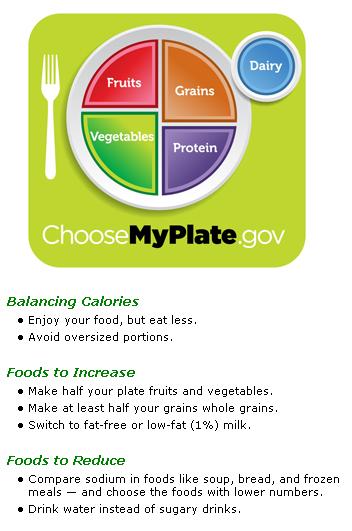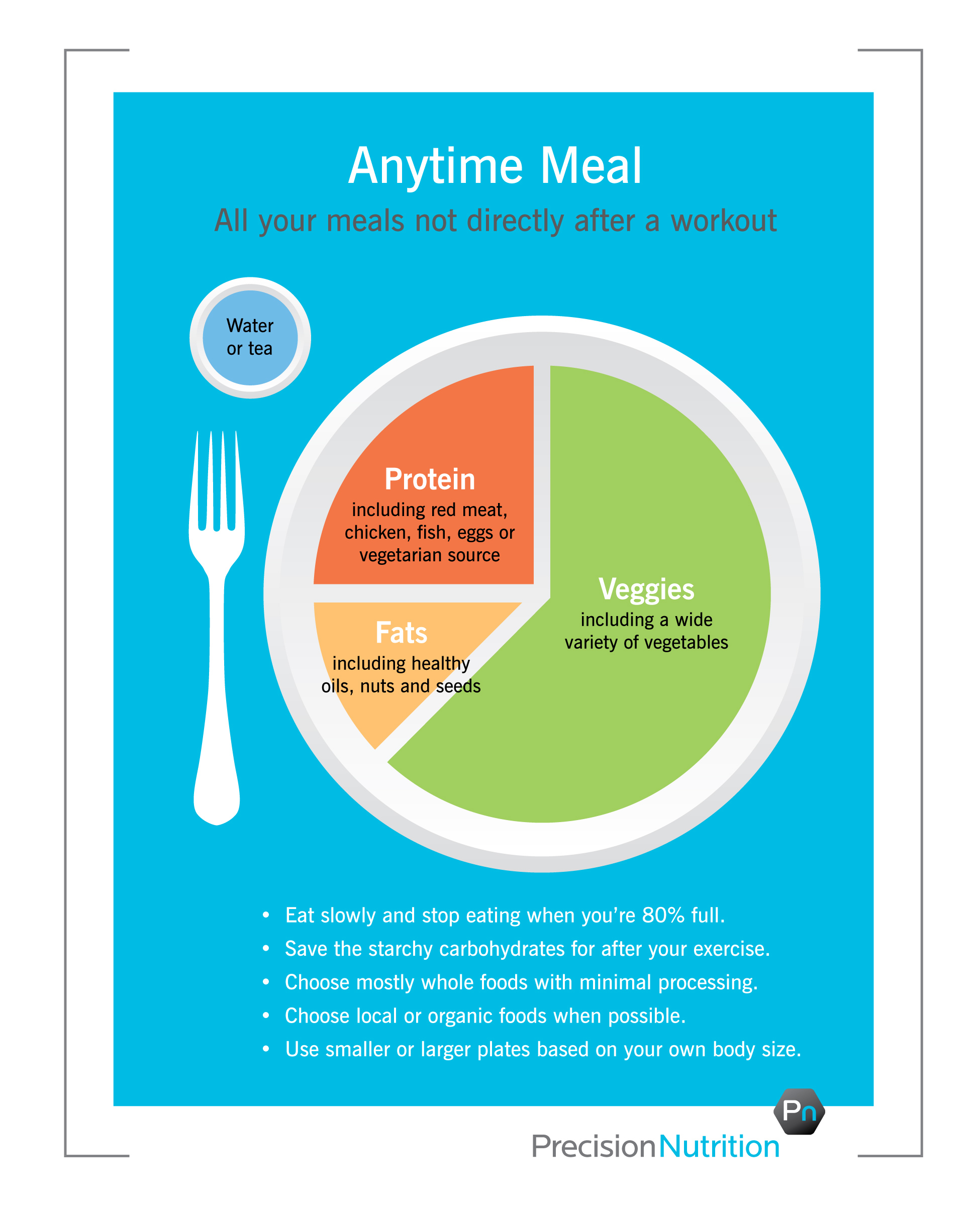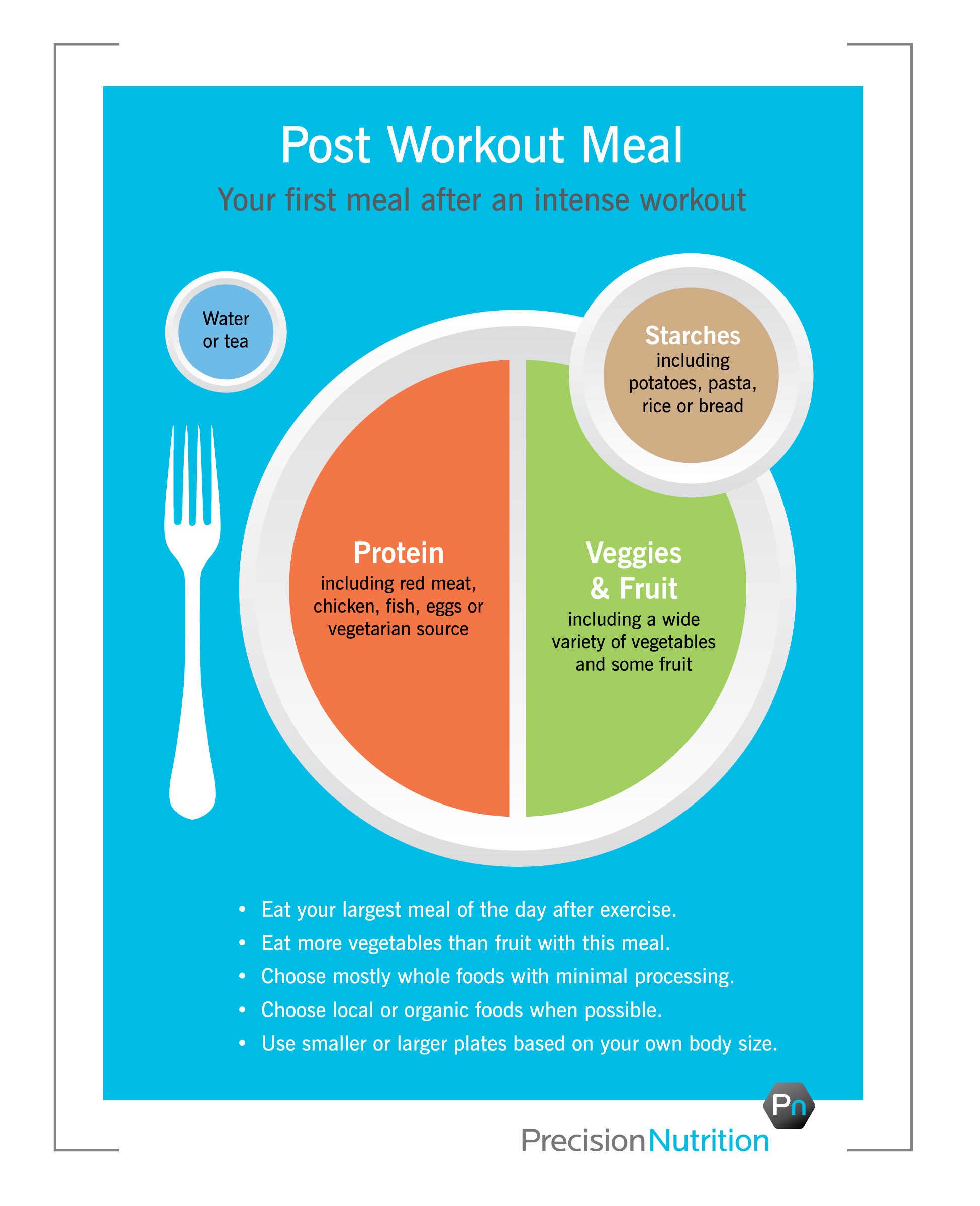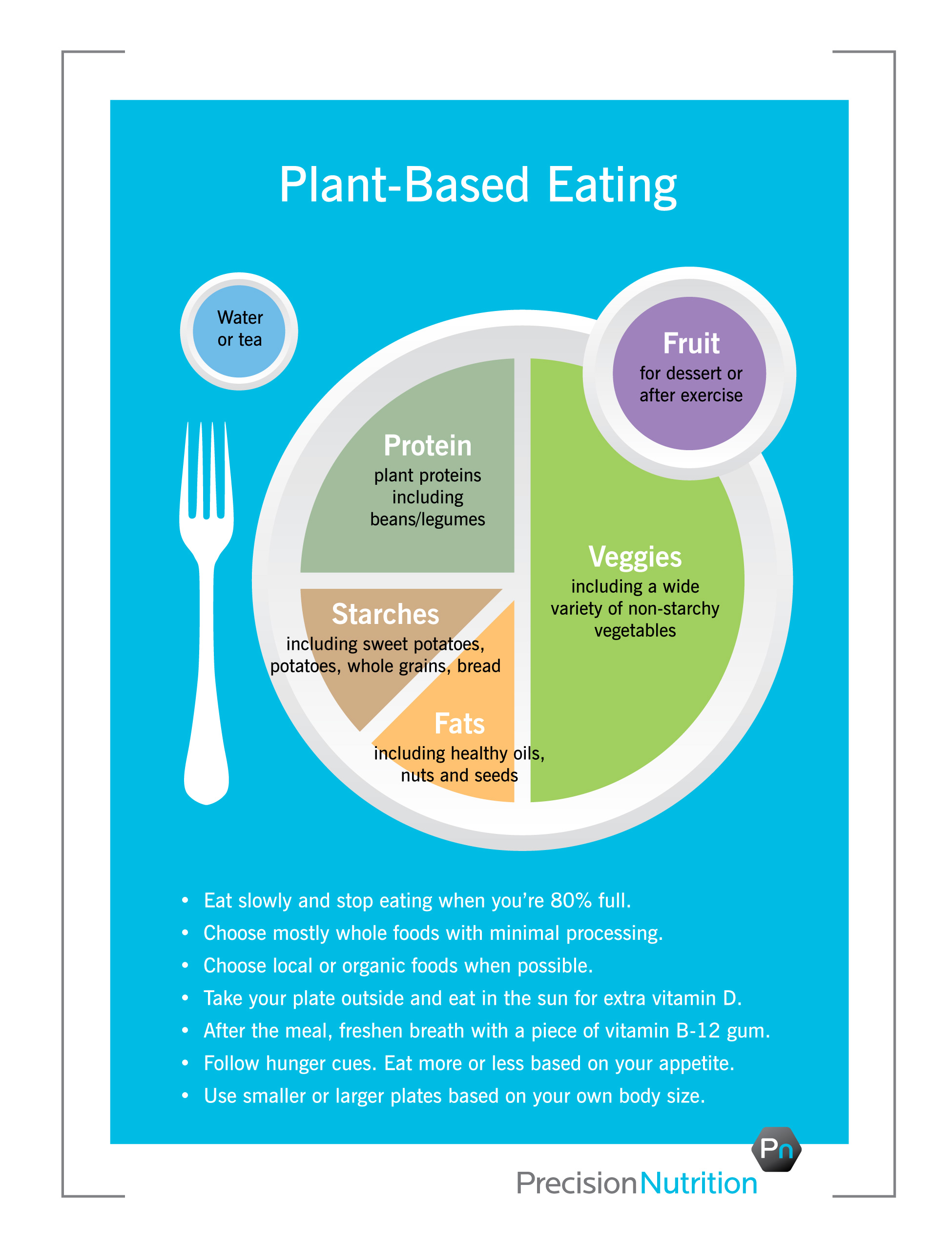The USDA has ditched the Food Pyramid and introduced MyPlate, a new graphic that shows a supposed “balanced diet”.
But are the recommendations on MyPlate designed for the health of the individual or the health of the food industry?
Dr. John Berardi discusses the short-comings of MyPlate and offers an alternative: The Precision Nutrition Plates.
These simple graphics show our suggestions based on nutritional science, our own research, and the success of thousands of real-world clients.
++
A few months back, the USDA ditched the iconic Food Pyramid in favor of a new design. In a bold and exciting move (please note the sarcasm), they took the food out of the pyramid and…placed it on a plate.
Here’s the new graphic:

Some praise the new design for its relevance — after all, most of us do put our food on plates before we eat it — and say the plate provides a good teaching tool for building our own plates at mealtime.
Of course, not everyone is happy. The biggest opponents are critical of its content, as not much has changed with the food choices since the 1990s. (We’ll get into some additional criticism in a minute.)
But before universally praising or condemning the plate, we should quickly talk about two things:
- Why was the plate created in the first place?
- What is it supposed to accomplish?
Why MyPlate?
Is MyPlate supposed to represent the ideal eating strategy for everyone? Is it an improvement on the way the US eats now? Is it a strategy for weight loss or a diet for optimal health?
To answer these questions, I turned to the official website for the MyPlate campaign, www.ChooseMyPlate.gov. According to their site, the image is designed:
“…to remind Americans to eat healthfully; [not] to change consumer behavior…”
It doesn’t seem like they’re not aiming too high with MyPlate. Instead, they’re just “reminding Americans to eat healthfully.”
Of course, that implies that Americans already know how to eat healthfully. Current obesity and food spending trends indicate otherwise. It also implies the USDA itself knows how to eat healthfully. I’m not sure about that either. (We’ll get into the science of that part in a minute.)
Finally, it implies that “healthfully” has a definition. I don’t think it does. The term seems so vague that it can mean anything to anyone. Want to lose weight? Surely that’s healthy. Build muscle? Healthy too, right? Drop cholesterol? Healthy. Combat type II diabetes? Healthy. But can one set of recommendations accomplish all those healthy things at the same time? Probably not.
Instead of getting into a debate about semantics, let’s talk about responsibility. Here’s a quote from Agriculture Secretary Tom Vilsack:
“We’re not telling people what to eat; we are giving them a guide… We’re not suggesting they shouldn’t have a cookie or dessert. That’s not what it’s about.”
I get the guide concept. But given the rapidly rising obesity levels in North America, shouldn’t someone start telling people to eat fewer cookies? Honestly, Tom?
All other criticisms aside for now, why can’t our most high-profile government food agency sack up and tell people to eat less empty-calorie food? I suspect it has to do with the USDA’s conflicted mission.
Who does the USDA work for?
It’s no secret the USDA has to balance all kinds of interests.
Sure, they’re trying to help spread the idea of healthy eating across the US. However, we’d be naive to ignore their other mission: to ensure the “health” of the food industry.
This is where conspiracy-minded folks go crazy. When food and profit are used in the same sentence, some people get uncomfortable. I urge you to take a gentler perspective. If the food industry isn’t profitable, it stops existing. If the food industry stops existing, a good portion of the world’s 6.7 billion people don’t get food.
So damning “big corporations” gets us nowhere. The USDA’s job of ensuring both our people and our food industries are “healthful” is an important, albeit thankless one. Any recommendations of any kind are likely to piss off someone, whether consumers or industry.
When healthy people and healthy business are at odds.
I appreciate the difficult task the USDA faces. Trying to make everyone happy and healthy is a daunting challenge, especially in cases where the recommendations that might make people healthier may run counter to recommendations that might make industry healthier.
For example, one of the most important healthy-eating messages – eat less – seems to run counter to a fundamental healthy-business message: buy more food.
So how does the USDA’s new MyPlate deal with the tension? Well, they tackle it admirably. Bravely, in fact. They tell people to “eat less” and to “avoid oversize portions.” I’m sure that created a bunch of industry blowback and resentment.
The only problem is that the “prescription” is so general and subject to interpretation that I’m not sure how much of an impact it has really made. Eat less than what? What exactly are “oversized portions”?
There also seems to be a hidden message in the new MyPlate guidelines, it’s as if the USDA is encouraging folks to “eat some of everything.” Some fruits, some veggies, some processed grains, some unprocessed grains, some protein, and some dairy. With every meal.
While this can be viewed as a positive message in promoting dietary variety, I’m not sure we should strive for “some of everything” with every meal. Further, it’s easy to see the marketing abuses that come next.
Here’s part of a statement released by USA Rice Federation President and CEO Betsy Ward,
“Grains comprise a large portion, signaling that USDA recognizes the importance of grains such as enriched white rice and whole grain brown rice in the diet.”
Huh. I wonder how that will play out.
The MyPlate recommendations pretty much support the promotion of just about any food. Nice for the food industry, not so awesome for minimally informed food consumers.
Where’s the nutritional science behind MyPlate?
I’m not a conspiracy theorist, so I don’t want to overplay the sometimes unhealthy relationship between the food industry and USDA. In addition, I’m not such a know-it-all to suggest that I have access to all the considerations important to the USDA.
One thing I do have access to, however, is the science. Because of this, it’s clear that science isn’t the only force at work when creating the MyPlate recommendations. Here are a few examples.
Too much dairy
“Dairy” continues to be singled out as its own food group. Yet millions of people cannot digest it well (lactose intolerance), are allergic to it (milk protein allergy), or choose not to drink it because of concerns with pasteurization and homogenization, as well as the appearance of potentially harmful hormones and antibiotics in dairy foods.
So why does dairy have its own group when all other sources of protein – everything from beans to seafood to nuts to meats – are lumped together?
Apologists might say it’s because of the calcium. However, why not create a calcium-rich group that also includes the sometimes more bio-available, non-dairy sources like green leafy vegetables or alternative options such as fortified nondairy milks?
Where’s the water?
Water is a nutrient. So why isn’t water represented anywhere on the graphic? Why is the only visible beverage dairy?
It all makes me wonder if maybe the dairy lobby has a stronger influence than the water lobby. (Just something to think about.)
Where are the healthy fats?
Where are the healthy fats like fish oils, olive oils, and other plant-based oils? In my opinion, the absence of healthy fats is the biggest oversight with the current MyPlate presentation.
Epidemiological studies are rock-solid. There are immense benefits from consuming a diet that includes a moderate amount of healthy fat, in the right balance. Indeed, if the American plate included more monounsaturated and omega-3 fatty acids – and likely fewer grains – we’d see a large decrease in the number of people suffering from hypertension, heart disease and stroke.
So, why are healthy fats not even mentioned?
Could the grain lobby have a stronger influence than the avocado lobby? (Again, something to think about.)
These are my biggest criticisms of the MyPlate recommendations. However, I do have a few other nitpicky things.
The difference between fruit juice and fresh fruit
The MyPlate recommendations suggest that any fruit or 100% fruit juice counts as part of the Fruit Group, and that canned and dried fruits are equivalent to fresh fruit.
Unfortunately, the differences between fruit juice, dried fruit, and fresh fruit are huge. They’re almost different foods in terms of digestion, absorption, and nutrient profile. (For the record, fresh fruits are much, much better.) So why are they all lumped together? Probably because it’s good for the food processing industry.
The difference between vegetable juice and fresh vegetables
The recommendations suggest that any vegetable or 100% vegetable juice counts as part of the Vegetable Group. Same problem. Vegetable juice (especially the store-bought kind) and vegetables are very different, with vegetables being superior.
High carbs for everyone?
Finally, the recommendation for grains and fruit with every meal suggests that a higher carbohydrate diet is ideal for everyone. Diabetes statistics suggest otherwise. So do body type and activity differences between people.
Higher carb diets are fine for those active folks with good glucose tolerance. But for folks who don’t exercise much, or who are experiencing early signs of impending type 2 diabetes – like a huge percent of the American population – a higher carb diet is the absolute worst eating plan to follow. Yet I suspect the grain lobby wouldn’t stand for any mention of eating fewer carbohydrates.
Did MyPlate get anything right?
While the new MyPlate recommendations are simply too watered down, too generalized, and too supportive of the food industry at the expense of consumer health, it’s important not to completely discredit it.
Compare MyPlate to a plate dominated by processed snack foods and French fries, served with a jumbo soda and MyPlate gets a huge win. After all, half of it is filled with veggies and fruits.
Also, simply including some protein with each meal, as MyPlate suggests, would benefit most people. I also like the idea of using a “protein” label instead of “meats and beans” as it better indicates all the food choices that fall into that group.
Lastly, prior food guides have encouraged a diet dominated by grains, and this model proposes to at least bring grain consumption back in line with other food groups. It also gets people thinking about eating more whole grains versus processed ones.
Yes, there are some good things about MyPlate.
Yet if you’re going to ransack the Food Pyramid and recreate a new set of healthy eating recommendations, why piss around with vague generalities and half-measures? (I shudder to think of how much time and money was spent on creating the MyPlate recommendations.) Why not come up with something really meaningful?
Introducing the Precision Nutrition plates
Instead of just sitting back and criticizing, we decided to come up with some plate-based recommendations of our own.
You’ll notice that each recommendation includes a few key components:
- what to eat (and drink)
- when to eat it
- how much to eat
Because exercise plays a big role in daily energy expenditure and nutrient tolerance, we decided that one plate isn’t enough. Instead, we need two plates.
Precision Nutrition’s Anytime plate
The first is an “Anytime” plate. The Anytime plate recommendations are for those who either don’t exercise — in which case, they’d follow these recommendations exclusively — or for those who do exercise, in which case, they’d eat Anytime meals for every meal outside the post-exercise period. (More on this in a minute.)

What’s on the PN Anytime Plate
As you can see, most of the plate is full of nutrient-dense, high fiber, low-calorie vegetables. Protein helps with appetite control, maintaining lean mass, and optimizing the metabolism. Healthy fats offer myriad benefits. The drink of choice is water or tea.
We suggest you choose smaller plates if you’re a smaller person and larger plates if you’re a larger person. And we highly recommend putting down the fork when you’re 80% full, not when the plate is empty.
We recommend minimizing starchy carbs until after exercise, which is when the body uses them most effectively. And we suggest choosing whole (less-processed) foods, with local and organic selections when possible.
Precision Nutrition’s Post Workout plate
The second plate we submit is the “Post Workout” plate. The Post Workout plate recommendations are for those who perform intense exercise. Eat a Post Workout meal soon after your intense exercise sessions only.

What’s on the PN Post Workout Plate
This plate helps us take advantage of the body’s metabolic response to exercise. It includes starchy carbohydrates and protein, which are great during times of increased glucose tolerance (during the post-exercise period). We also advise a mix of vegetables and fruits.
You’ll notice there isn’t much fat here. A higher fat meal post-workout slows the digestion and the assimilation of protein and carbohydrate. So we recommend getting most dietary fat during Anytime meals and most dietary carbohydrates during PW meals. Keep in mind we’re not suggesting you avoid fat. Just minimize added fat.
Notice that the Post Workout portion is slightly larger, as we add a small side dish of starchy carbohydrates on top of a full plate of protein and fruits/veggies. Of course, one should use smaller or larger plates based on body size.
In terms of food selection, the Post Workout plate is still based on whole, unprocessed foods, with local and organic selections when possible.
For the plant-based eater
Although plant-based eaters (i.e. vegans) make up only 1-2% of the population, they’re some of the most nutritionally conscious and proactive individuals. That’s why we decided to come up with a plant-based plate with the help Ryan Andrews, a long-time plant-based eater.

What’s on the PN Plant-Based Plate
A wide variety of non-starchy vegetables, combined with a protein source and healthy fat, should dominate the plant-based eater’s plate, just like the Anytime meal above.
We recommend including smaller amounts of minimally processed fruit and starches to meet energy needs. And, as with all meals, regardless of timing or type, adjust plate size and total intake to body size and energy needs. And stop eating at 80% full.
Science + real world results = the perfect plate recommendations
We suggest that the Anytime and Post Workout plates above are more useful than MyPlate for real people, especially those who exercise. These plates are based on solid scientific data and — perhaps most importantly — on the real-world eating experiences (and long-term success) of thousands of clients.
You see, Precision Nutrition currently runs the world’s largest body transformation program. Over 10,000 men and women have taken part in PN Coaching, and during the last 5 years alone, our clients have lost more weight than in all 11 seasons of the Biggest Loser combined.
Not surprisingly, the recommendations we’ve outlined above form the foundation of what we teach our clients. So not only does this approach make sense, it works.
Download the Precision Nutrition plates
We created a single guide that summarizes all our our “plate” recommendations. Click here to download it, print it out, and share them with friends, family, or clients.
Eat, move, and live…better.©
The health and fitness world can sometimes be a confusing place. But it doesn't have to be.
Let us help you make sense of it all with this free special report.
In it you'll learn the best eating, exercise, and lifestyle strategies – unique and personal – for you.





Share